Massage for infants is an excellent preventative and effective treatment for many diseases. Before the age of one year, it is necessary to regularly practice massage: massage for infants for 2 months will not differ radically from how massage for infants for 3 months will be performed. In addition to the invaluable benefits of massage techniques, mother’s gentle touches bring positive results.

The baby feels the warmth and tenderness of his mother's hands
This procedure is a set of classical techniques that have a mechanical effect on certain areas of the body. Gymnastics in combination with massage techniques is used for the treatment and prevention of various diseases of infants. Massage stimulates metabolic processes in the skin, improving the functions of the sweat and sebaceous glands, improves blood circulation in the skin and muscles.
The mechanism of action of massage for infants
During massage techniques, skin receptors receive an impact; this impact transmits impulses to the cerebral cortex, which activate neighboring areas responsible for various functions of the body. By itself, acting on the skin, it causes renewal of the epithelium. A complex session in the right relationship with children's gymnastics improves blood circulation, affecting lymph flow and activating metabolism.
As for gymnastics, its tasks include the formation of the correct joint-muscular system, as well as the development of the most correct and rational stereotype of movement in the baby. Massage for a 3-4 month old baby in combination with gymnastics will not differ in variety. But these sensations will also bring a new flow of emotions into the baby’s life. In this case, massage acts as a kind of stimulus for psychological and physical development. It can also be said that regular classes at the same time will teach the child from an early age to a certain routine and the correct rhythm of life. During the massage, such an important procedure as hardening and taking air baths also takes place.
Indications and contraindications for massage for infants
The combined ratio of gymnastics and massage should be used from the age of one and a half months as a method of strengthening the baby’s body and the correct formation of physical development. But there are also situations in which massage is prescribed at an earlier date.
As a rule, massage is prescribed to premature babies and children who are bottle-fed. If a child is in any way lagging behind in physical development, those who have suffered from any illness are also prescribed massage and gymnastics. If a child has a musculoskeletal disease or a disease of the nervous system, massage in these cases is mandatory.
Contraindications will be purulent skin diseases, any chronic and acute diseases, blood disease and bleeding, any inflammatory processes.
Massage technique for infants
Massage for infants is a very delicate matter. The technique includes four techniques that are included in classic massage - stroking, rubbing, kneading and vibration. The most commonly used techniques in practice are stroking, rubbing and vibration.
- Stroking
You should start with light stroking. This technique has a calming effect on the nervous system, activates skin nutrition, strengthens muscles, improving elasticity and lymph circulation. Metabolism and oxygen consumption by tissues improve, this helps to increase appetite, weight gain and improve the general condition of the child. This technique is especially necessary for those children who are underweight.
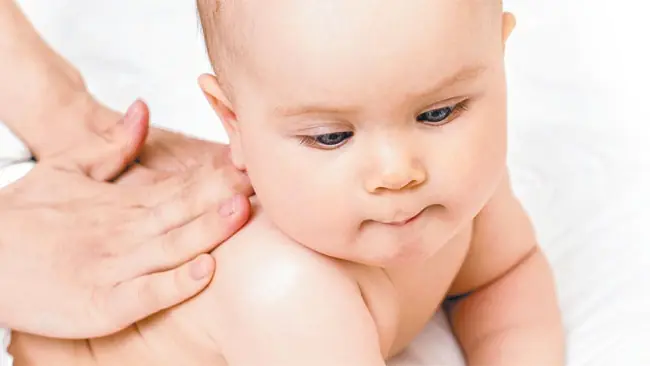
All techniques are performed with gentle, light movements.
- Trituration
This technique activates blood flow to the skin, muscles and tissues. It should be performed in a circular direction with one or more fingers. As a rule, the rubbing technique is used for diseases of the musculoskeletal system; most often, rubbing the child’s lower leg is used.

Rubbing is performed in a circular direction
- Kneading
Kneading, unlike other baby massage techniques, is used to influence deep tissues, which activates blood circulation and nutrition. There is an improvement in muscle tone and contractility. Kneading is most often used in the treatment of rickets and its residual phenomenon, which is expressed in muscle weakness and delayed development of the musculoskeletal system.

Kneading helps activate blood circulation
- Vibration
This technique is expressed in shaking the underlying tissues, an energy technique. Vibration is rarely used as a massage for infants. It is prescribed for special indications, such as strengthening the spinal muscles and for children with increased body weight.

Vibration can be used to complete the procedure.
All movements and techniques are carried out very gently, smoothly and accurately, since the child’s skin is very vulnerable and delicate, sensitive to all movements. Please note that almost all techniques are stimulating to the nervous system.
Massage technique for infants
We invite you to familiarize yourself with the detailed photo instructions for the massage.
Crossing arms over chest
Previously, this movement was called “embracing movements with the arms.” The child should lie on his back, with his feet facing you. Place your thumbs in the child’s palms and hold the hands with the rest. First, spread your arms 90 degrees relative to your body, and then bring them together as shown in the figure. when crossing, hands should alternately change - first the left one on top, then the right one. The movement must be repeated 6-8 times.
Crossing your arms is designed to develop muscles and the shoulder girdle. After 4 months, you can stop holding your baby’s hands.

Technique of the exercise “crossing your arms over your chest”
Hand massage
The first step is to stroke your hands. Then proceed to rubbing, and then to kneading. With your left hand, take the baby's left hand and begin to rub it, first with one finger, then with two, and then with three fingers. You need to finish with stroking.
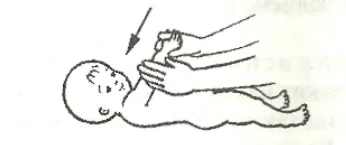
Baby hand massage
Turn from back to stomach with support from left hand
With your right hand, or rather with your thumb, middle and index fingers, fix both of the baby’s shins, just above the ankle joints. Place the index finger of your left hand in the child’s palm so that he grabs it. Using your right hand, move your baby's legs so that the pelvis can rotate slightly to the right. Following the movement of the pelvis, the child must turn his head and torso in the same direction. This triggers the pelvic rotation reflex. Holding your child's hand, help him turn all the way so that he is in a position on his stomach.
The second turn is performed identically, only the movement of the pelvis moves to the left. There is no need to pull the child’s arms and legs, otherwise he will not learn to roll over on his own.
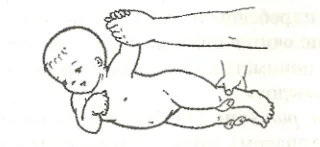
Turn from back to stomach
Back massage
After 3 months, kneading is added to the basic techniques. With the fingers of both hands, begin to simultaneously make circular translational movements, intensively stretching the muscles on both sides of the spine, directed from the lower back to the neck.
After 4 months, you can introduce the tapping technique. This technique should be performed on the long back muscles, starting from the buttocks to the head. Finish the back massage with light stroking.

Back massage for baby
"Swimmer's Position"
To perform this exercise, the child needs to be placed on his stomach, with his feet facing you. With your right hand, secure both of the child’s legs so that the middle finger is on the left, the index finger is between the shins, and the rest are on the right. With your right hand, gently lift the baby's legs, placing your palm under the stomach.
In this position, the head and shoulder girdle are raised, and the spine is in a state of extension. Performing this exercise works all the back muscles.
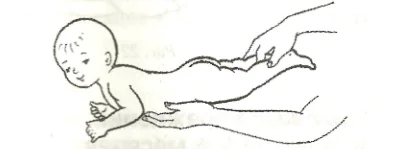
Exercise "Swimmer's position"
Arm flexion and extension
Now we put the baby on his back, with his feet facing him. Place the thumbs of both hands in your palms, and hold the baby’s hands with the rest if necessary. Alternately begin to bend and straighten your arms at your elbow joints. When bending, your fingers should touch the shoulder joint, not the chest. In this position, the child will turn from side to side.
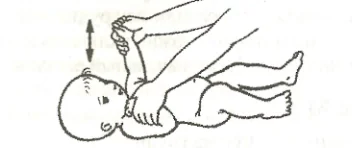
Arm flexion and extension technique
Basic rules for massage for infants
- If the baby is in a bad mood, cries, or is capricious, the massage for newborns should be rescheduled for another time;
- The optimal time for a massage is in the morning, an hour before feeding and 2 hours after it, the optimal room temperature is 20-22 degrees;
- It is best to massage on a changing table;
- Before starting the massage procedure, wash your hands thoroughly with soap, there should be no long nails on your fingers, remove all rings, bracelets, watches so as not to damage the baby’s delicate skin.
Gymnastics on the ball
Before you begin exercises on the ball, place a diaper on the ball.
- Place your child's back on the ball. Holding it by the sides, smoothly roll the ball from side to side, then back and forth. Repeat the exercise 10 times.
- Place the baby on his tummy. Your legs should be bent and pressed against the ball. Your assistant should hold the baby's legs in this position, and you take the baby's arms in yours and slowly pull them towards you, then return to the starting position. Repeat 10 times.
- The baby remains in the original position on his tummy. Take his hands in yours and tilt the ball so that the child touches the table surface with his open palms. Make sure your baby doesn't hit his head.
Sometimes, massage, in combination with children's gymnastics, can replace all other treatment methods. This necessary form of prevention of many diseases should not be neglected.



